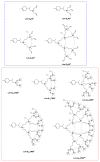Synthesis of Carbosilane and Carbosilane-Siloxane Dendrons Based on Limonene
- PMID: 36015536
- PMCID: PMC9416742
- DOI: 10.3390/polym14163279
Synthesis of Carbosilane and Carbosilane-Siloxane Dendrons Based on Limonene
Abstract
In this work, carbosilane dendrons of the first, second, and third generations were obtained on the basis of a natural terpenoid, limonene. Previously, we have shown the possibility of selective hydrosilylation and hydrothiolation of limonene. It is proved that during hydrosilylation, only the isoprenyl double bond reacts, while the cyclohexene double bond does not undergo into the hydrosilylation reaction. However, the cyclohexene double bond reacts by hydrothiolation. This selectivity makes it possible to use limonene as a dendron growth center, while maintaining a useful function-a double bond at the focal point. Thus, the sequence of hydrosilylation and Grignard reactions based on limonene formed carbosilane dendrons. After that, the end groups were blocked by heptamethyltrisiloxane or butyllithium. The obtained substances were characterized using NMR spectroscopy, elemental analysis and GPC. Thus, the proposed methodology for the synthesis of carbosilane dendrons based on the natural terpenoid limonene opens up wide possibilities for obtaining various macromolecules: dendrimers, Janus dendrimers, dendronized polymers, and macroinitiators.
Keywords: carbosilane dendrimers; hydrosilylation; limonene; siloxanes.
Conflict of interest statement
The authors declare no conflict of interest.
Figures


Similar articles
-
A convergent growth approach to electroactive ferrocene rich carbosilane- and siloxane-based dendrons, dendrimers, and dendronized polymers.Dalton Trans. 2023 May 2;52(17):5663-5679. doi: 10.1039/d2dt03983d. Dalton Trans. 2023. PMID: 37021638
-
Antibacterial and antifungal properties of dendronized silver and gold nanoparticles with cationic carbosilane dendrons.Int J Pharm. 2017 Aug 7;528(1-2):55-61. doi: 10.1016/j.ijpharm.2017.05.067. Epub 2017 May 31. Int J Pharm. 2017. PMID: 28577968
-
PEGylated AgNP covered with cationic carbosilane dendrons to enhance antibacterial and inhibition of biofilm properties.Int J Pharm. 2019 Oct 5;569:118591. doi: 10.1016/j.ijpharm.2019.118591. Epub 2019 Aug 5. Int J Pharm. 2019. PMID: 31394187
-
Strategies for the Preparation of Phosphorus Janus Dendrimers and Their Properties.Molecules. 2023 Jul 21;28(14):5570. doi: 10.3390/molecules28145570. Molecules. 2023. PMID: 37513445 Free PMC article. Review.
-
Carbosilane and carbosiloxane dendrimers.Molecules. 2009 Sep 22;14(9):3719-30. doi: 10.3390/molecules14093719. Molecules. 2009. PMID: 19783954 Free PMC article. Review.
Cited by
-
Synthesis and Thermal Properties of Bio-Based Janus Ring Siloxanes Incorporating Terpenes and Terpenoids.Materials (Basel). 2024 Oct 31;17(21):5348. doi: 10.3390/ma17215348. Materials (Basel). 2024. PMID: 39517618 Free PMC article.
References
-
- Yokoyama S., Otomo A., Nakahama T., Okuno Y., Mashiko S. Dendrimers for Optoelectronic Applications. In: Schalley C.A., Vögtle F., Dendrimers V., editors. Topics in Current Chemistry. Volume 228 Springer; Berlin/Heidelberg, Germany: 2003. - PubMed
Grants and funding
LinkOut - more resources
Full Text Sources

